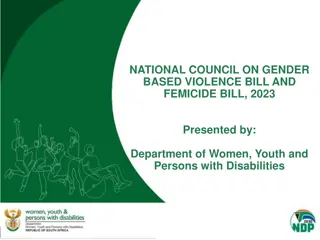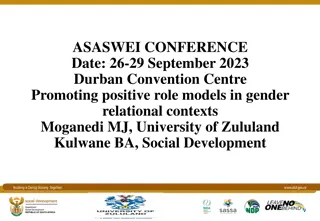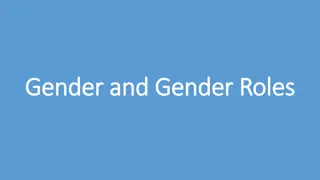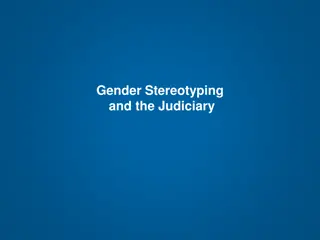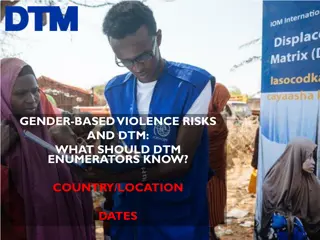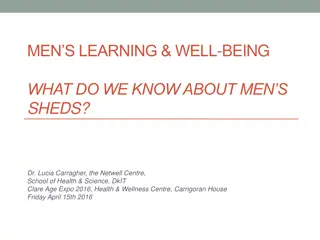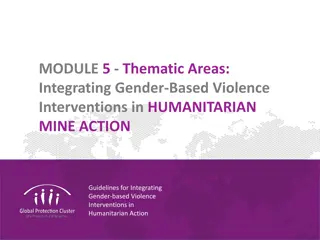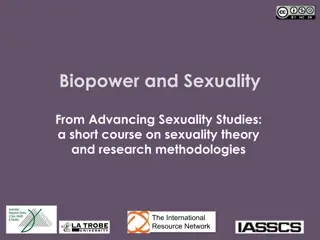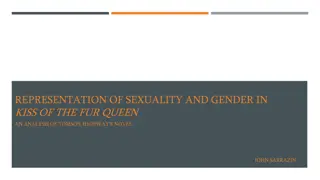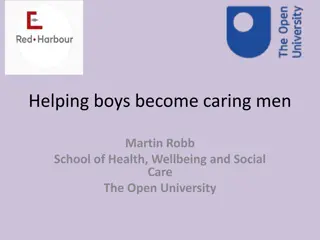Understanding Gender-Based Violence and Sexuality in Men and Boys
This module delves into the critical concepts of gender-based violence (GBV) and sexual violence against men and boys (SVAMB). It explores the nuances of power dynamics, different forms of power, the impact of gender on roles and opportunities, and the relationship between sex, gender, and gender identity. By examining the definitions and implications of GBV and SVAMB, this module aims to create awareness and understanding of the pervasive issues surrounding violence in various contexts.
Download Presentation

Please find below an Image/Link to download the presentation.
The content on the website is provided AS IS for your information and personal use only. It may not be sold, licensed, or shared on other websites without obtaining consent from the author. Download presentation by click this link. If you encounter any issues during the download, it is possible that the publisher has removed the file from their server.
E N D
Presentation Transcript
MODULE 1 Introduction to gender-based violence (GBV) and sexual violence against men and boys (SVAMB)
Introduction Brainstorm: Defining gender-based violence (GBV) What does it mean? 2 Module 1
Introduction Power Gender equality Violence Informed consent 3 Module 1
Power Person Person Person ME Person Person Person 4 Module 1
Power Different forms of power: Economic Political Social Age-related Educational Physical Gender-based Class-based Ethnicity-based Race-based Religion-based Ability-based 5 Module 1
Power Power is the capacity to make your own decisions and take action Directly related to choice Fewer choices Greater Increased vulnerability to abuse disempowerment All of our relationshipsare affected by the exercise of power 6 Module 1
Sex and gender SEX GENDER social differences between women, men, transgender and other gender diverse persons not physical and biological Physical and biological differences between female, male and intersex persons deeply rooted in every culture, varying from one culture to another Changeable over time 7 Module 1
Sex and gender Gender and sex are related to but different from gender identity. Gender identity refers to a person s deeply felt, internal and individual experience of gender, which may or may not correspond to the person s physiology or designated sex at birth. A transgender person is someone whose gender identity differs from the sex they were assigned at birth: For example, a baby is born as a boy but later does not identify or feel like a boy. They may identify as a girl, or they may not feel like they are either a boy or a girl. Their sex and their gender do not align. 8 Module 1
Sex and gender Your gender has an impact on: Roles Responsibilities Expectations Privileges Rights Limitations Opportunities Access to services 9 Module 1
Violence What is violence? 10 Module 1
Violence Violence is any act that causes harm. It involves the use of some type of force, real or implied. 11 Module 1
Violence is not just physical can include emotional, social/economic abuse, coercion or pressure can be hidden is context-specific 12 Module 1
Consent What is consent? 13 Module 1
Consent Consent means that people make an informed choice, freely and voluntarily, in an equal power relationship. Acts of GBV and SVAMB occur without informed consent. Saying yes does not = consent. "Yes" is not true consent if said under duress. Children under the age of 18 are unable to give informed consent for acts such as female genital mutilation/cutting (FGM/C), marriage, sexual relations, etc. 14 Module 1
Consent Freely given Reversible Informed Enthusiastic Specific 15 Module 1
The definition of GBV Gender Human Rights Power GBV Lack of Consent Violence 16 Module 1
The definition of GBV GBV is an umbrella term for any harmful act that is perpetrated against a person s will and is based on socially ascribed (i.e. gender) differences between males and females. It includes acts that inflict physical, sexual or mental harm or suffering, threats of such actions, coercion and other deprivations of liberty. 17 Module 1
The definition of GBV The term GBV is used to underscore how systemic inequality between males and females acts as a unifying and foundational characteristic of most forms of violence perpetrated against women and girls. The term highlights the gender dimension of these types of acts the relationship between the subordinate status of women and girls in society and their increased vulnerability to violence. Acts of GBV violate a number of universal human rights protected by international instruments and conventions. Many but not all forms of GBV are illegal and are viewed as criminal acts in national laws and policies. 18 Module 1
Recap GBV involves the abuse of power and the use of some type of violence that causes harms. GBV is rooted in gender inequality and occurs without informed consent. Girls are at risk of multiple forms of GBV from birth throughout adolescence. GBV is mostly perpetrated by men and boys and occurs in the family and general community; in institutions such as schools; and in workplaces. 19 Module 1
GBV Tree 20 Module 1
Women and girls with increased risk of GBV Adolescent girls Unaccompanied girls Women and girls with disabilities, especially intellectual disabilities Lesbian, bisexual, transgender women and girls (and others with different sexual orientation or gender identity) Women selling sex Others? 21 Module 1
Violence against children and GBV 1 in 10 girls under 18 (approximately 120 million) worldwide have experienced sexual assault About 10% of the world's children are not legally protected from corporal punishment. Over 1 in 3 students aged 13 15 experience bullying worldwide. Approximately 1 in 4 children under the age of 5 live with a mother who is a victim of intimate partner violence. Children can be direct victims of GBV or are indirectly harmed by GBV, as witnesses GBV has multiple detrimental and lasting effects on children s physical, sexual, reproductive and psychological health, well-being and development, and can negatively impact educational outcomes Violence against children and GBV tend to occur together, especially at the household level. Both forms of violence have multiple shared drivers or risk factors, including social norms that condone men s use of violence (either against children or against women) as a form of discipline and control. Hence, addressing these risk factors can help reduce both GBV and VAC 22 Module 1
Discussion What do we know about GBV in this setting? 23 Module 1
GBV in countries of origin 76% of adolescent girls in Ethiopia have experienced at least one form of GBV In Egypt, among girls and women aged 15 to 49 years, nearly 9 in 10 have undergone FGM In Syria, the conflict has exacerbated GBV and patriarchal norms FGM is nearly universal among girls and women of reproductive age in Guinea and Somalia (97%) 87% of Afghan women have experienced at least one form of GBV In Niger, 3 in 4 young girls were married before the age of 18 24 Module 1
GBV on migration routes to Europe 95% of victims of trafficking for sexual exploitation in Europe are women and girls. An estimated 80% of Nigerian women who arrived in Europe by sea in 2016 were trafficked for purposes of sexual exploitation (IOM, 2017). 30 out of 31 migrant women in Sicily reported being raped in Libya (Oxfam, 2017). Most girls detected on the Eastern Mediterranean route have been trafficked for sexual exploitation, while most boys for forced labour. He sold me for money [then] told me that they would release me on one condition, to embark for Italy for prostitution and repay him" - a girl in Italy 25 Module 1
GBV risks once in Europe Risk of trafficking persists. Invisibility of unaccompanied and separated girls places them at high risk of sexual exploitation. Increased risk of GBV inside reception facilities (lack of security, privacy, lack of access to critical services). Intimate partner violence remains widespread among migrant and refugees, and is compounded by the emphasis on family unity in protection systems. One study estimates that 69% of female migrants have been subject to sexual violence since their arrival in Europe. 26 Module 1
Recap The key aspects of GBV can be visualized through the GBV Tree: GBV is rooted in the abuse of power, gender inequality and disrespect for human rights. GBV can take different forms, including sexual violence, sexual exploitation, child marriage and intimate partner violence (IPV). GBV can be exacerbated by contributing factors, such as poverty and conflicts. Girls and women on the move face specific GBV risks before, during and after migration. There are specific groups of women and girls that may be at particular risk of GBV. 27 7/10/2024 Module 1
Understanding sexual violence against men and boys (SVAMB) Module 1 28
SVAMB & GBV The root causes of GBV against women and girls include abuse of power, gender inequality, disrespect for human rights. SVAMB is sometimes used to undermine masculine norms but is not driven by gender inequality itself. Sexual violence against men is not intended to keep men subordinate to women or further inequality between men and women. Therefore, we do not use the term 'GBV' to describe sexual violence against men and boys. 29 Module 1
SVAMB is perpetrated Against: Adult men Adolescent boys Young boys Older men Gay and transgender men and boys Any man or boy In: Home countries Conflict settings Migration routes Refugee and displaced settings, including in Europe 30 Module 1
What do we know? What do we know about sexual violence against men and boys who have arrived in this setting? 31 Module 1
Sexual violence in countries of origin Refugees and migrants in Europe originate from throughout West, Central and East Africa, as well as the Middle East and South Asia. Men and boys are targeted for sexual violence in specific conflict- affected countries of origin (e.g., DRC, Syria, South Sudan). Some, including adolescent boys and gay/bisexual men and boys, may be fleeing sexual abuse by their families and communities. 32 Module 1
Sexual violence in country of origin: Syria Of 138 male detainees in Syrian detention centres, almost 90% reported some form of sexual violence (LDHR, 2019). When I was in detention in Syria I was tortured in every possible way . At night, they hung us from our hands they tortured us with electricity to the genitals. They put a stick inside of me . All we could hear were people saying, Stop! Don t! My [anus] is bleeding I thought we would die. (UNHCR, 2017) 33 Module 1
Sexual violence en route to Europe Of 55 male migrants who had transited through Libya to Europe since 2017, 78.2% reported witnessing sexual violence and 18.9% disclosed experiencing sexual violence in Libya (Reques, 2020). There is no person who can say that there was no [sexual] violence. Each person experienced violence from Niger, to Libya, to Italy . No one can say that it didn t happen. 'Oumar' from Mali, living in Italy (Women s Refugee Commission, 2019) 34 Module 1
Common forms of SVAMB In conflict-affected settings: Forced witnessing of sexual violence against others Genital violence, such as burns, electroshock, amputation Anal rape, including with objects Forced sexual violence against others In refugee/displacement settings: Sexual exploitation Sexual abuse of younger boys Rape and other forms of sexual violence 35 Module 1
Vulnerable groups Adolescent boys and young men Unaccompanied boys and adolescents Young boys Gay, bisexual and transgender men and boys (and others) Male detainees Men selling sex Men and boys with disabilities Others? 36 Module 1
Recap GBV and SVAMB have both similar and different root causes: SVAMB is sometimes perpetrated to undermine traditional masculine norms of men as powerful protectors; however, men do not experience systematic gender inequality as women and girls. SVAMB can be perpetrated against anyone and the vast majority of perpetrators appear to be (heterosexual) men. Sexual violence is perpetrated in the home countries of refugees and migrants, along migration routes, and in countries of refuge, including throughout Europe. There are specific groups of men and boys that may be particularly vulnerable to sexual violence. 37 Module 1
Consequences of GBV and SVAMB GROUP WORK Group 1: Physical consequence Group 2: Mental health consequences Group 3: Social consequences 38 Module 1
Possible consequences Physical health consequences Psychological health consequences Social and economic consequences Physical injuries Depression Victim blaming Sexually transmitted infections, including HIV Anxiety Stigmatization Unwanted pregnancies Self-blame Rejection, including divorce Unsafe abortions Post-traumatic stress disorder Isolation Genital Injury (can include severe injury such as castration, lacerations and other injuries) Decreased earning capacity/contribution Nightmares Fistulas Alcohol or drug abuse Increased poverty Death by suicide, honor killings, femicide Suicidal thoughts/actions Risk of re-victimization 39 Module 1
Multi-sectoral response for survivors and barriers to care Module 1 40
Services for survivors Survivors of sexual violence and GBV have the right to survivor-centred care and support services to help them heal and recover from the consequences of violence. GROUP ACTIVITY Considering what we know so far, what kinds of services and support does a survivor need to reduce the harmful consequences and enable their recovery? 41 Module 1
Services for survivors and barriers to care Survivors often face many barriers to accessing services. Examples: Fear of confidentiality breaches Fear of the reactions of communities and families Being unaware of available services Shame and feelings of self-blame Negative attitudes from service providers Gender-specific barriers, including myths and misconceptions about SVAMB and GBV 42 Module 1
Disclosure challenges for male survivors Male survivors often do not directly disclose experiencing sexual violence. Instead, they may describe: Vague complaints about pains all over the body Pain in the back, lower back Insects crawling in my skin Erectile or other sexual dysfunction Problems with defecation or urination Poor hygiene Symptoms of depression, anxiety and anger Risk-taking and unhealthy coping mechanisms, like excessive alcohol use or violence to deal with anger 43 Module 1
Recap GBV and SVAMB can have physical, mental health and social consequences. There are health, psychosocial, security and legal services that are essential to support a survivor to reduce the harmful consequences of their experiences and enable their recovery. Survivors often face many barriers to accessing service and some are gender-specific. There are many harmful myths and misconceptions around SVAMB and GBV that help to create a culture of silence around the issue. 44 Module 1


